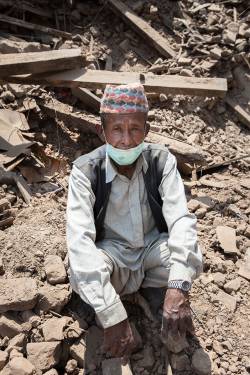 When I arrived at Kathmandu airport about a week ago, one of the first things I noticed was the number of people wearing face masks. I thought that this might be a precaution against disease following the earthquake.
When I arrived at Kathmandu airport about a week ago, one of the first things I noticed was the number of people wearing face masks. I thought that this might be a precaution against disease following the earthquake.
When I stepped out of the airport I realised why people wore them. There was dust everywhere.
I’ve never been to Kathmandu before, so I don’t know if all this dust is status quo. I guess it doesn’t help that a lot of the houses and historical structures were made of bricks… Bricks that have been pulverised by the earthquake, decades of memories and centuries of history obliterated into tiny specks.
Sea of rubble
On my visits to Bhaktapur and Sankhu, two heavily-affected areas by the earthquake, the dust became even worse. Clouds billowed across the debris when even a mild breeze hit.
The streets have become a sea of rubble, sometimes impossible to tell whether you are walking on the road or on what was once somebody’s house.
I saw families tirelessly clearing the debris from their homes in search of anything they could salvage from their treasured possessions trapped underneath.
It’s not just the dust that is shrouding people’s vision. When I spoke to older people, most of them did not know what to do next.
Worried for the future
We found Prakash*, 70, trying to clear out six feet of rubble that cascaded down a hill and buried his house. Prakash suffers from asthma, and has not been taking any medicine for his condition. The dust from the debris is making his asthma worse, he said, yet he continues to plough through the rubble.
Prakash is worried for his family’s future:
“I have not saved enough money to rebuild our house. I also have to pay for my grandchildren’s tuition. I don’t know where all that money is going to come from.”
Over and over again, I have heard the same sentiment from the older people I have met:
“I feel so helpless.”
“I’m so tired. I don’t know what to do.”
“How can I rebuild my house? I don’t have that kind of money.”
“The monsoon season is coming, and we’re still living in the field.”
Recovering from tragedy
Older people are at a loss as to how they can recover from this tragedy and return to a normal life. I suppose this is true for almost everybody affected by the disaster, but it seems to hit older people the worst.
When your most economically productive years are behind you, starting from scratch is a far more terrifying reality.
For older people, there seems to be a haze obscuring what lies ahead, and it’s not dust. It is the fear of an uncertain future.
To help older people like Prakash and their families, we are working through our local partners. So far, we have given more than 2,100 older people money to spend on urgently needed items.
Giving older people money allows them to buy whatever they need at this difficult time. Some people may need items for shelter; whereas others may need food and clean water. Within the next couple of weeks, we’re planning to reach 10,000 older people.
How you can help
You can support older people whose lives have been devastated by the Nepal earthquake:
*name has been changed
